Nicaragua is the largest country in Central America and a less-trodden path for travellers. This overlooked country is your ticket to an authentic, affordable adventure and it’s one of the most budget-friendly destinations in Central America. With only one major city (the capital, Managua) and a handful of smaller ones, Nicaragua thrives on its myriad of charming towns and unique locales. Each destination has its own flavour. As you journey from the active Pacific coast to the jungle-laden Caribbean coast, you’ll encounter a dramatic shift in culture.
Nicaragua’s cities and towns are a perfect launchpad to explore its surroundings. The country is teeming with natural beauty, from stunning lakes like Lake Nicaragua, which covers a significant portion of the country, to its unlimited beaches and islands that line each coast. Nicaragua is part of the Pacific Ring of Fire, which means there is no shortage of volcanoes and dramatic landscapes to discover.
Getting around couldn’t be easier with Nicaragua’s local buses, affectionately called “chicken buses”. Chicken buses are repurposed American school buses with cheap fares and frequent service that can take you city and town hopping and everywhere in between. Nicaragua truly has something for everyone; it’s a diverse and captivating country worth exploring.
20 Nicaragua Cities And Towns
Top Tours
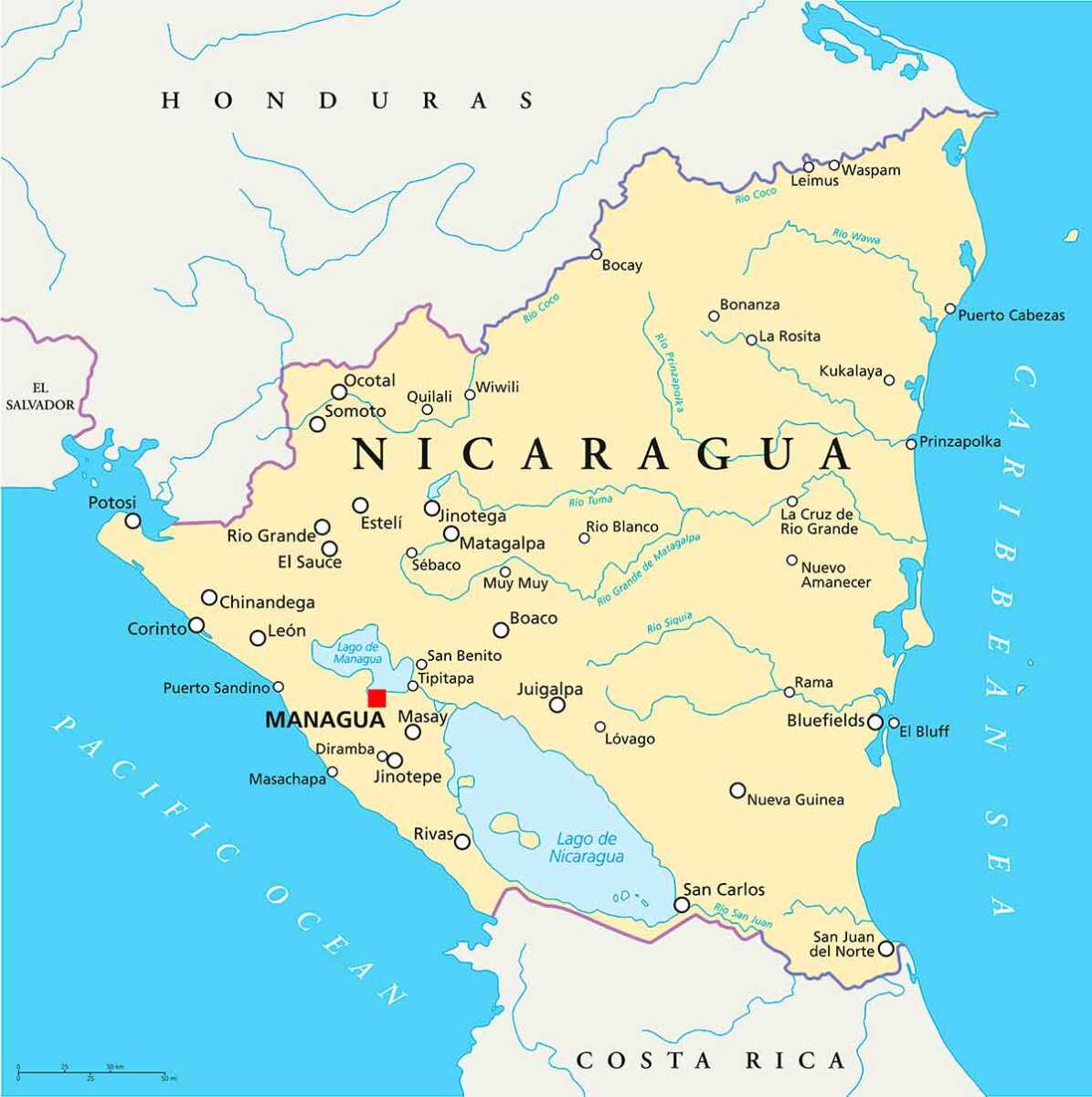
- Volcano Boarding Private Tour – an adventure to remember!
- Night Tour to the Masaya Volcano – explore the laval-filled crater rim.
- Tlakualli Food Tour – feast on the rich cuisine of Nicaragua.
Cities In Nicaragua
1- Granada
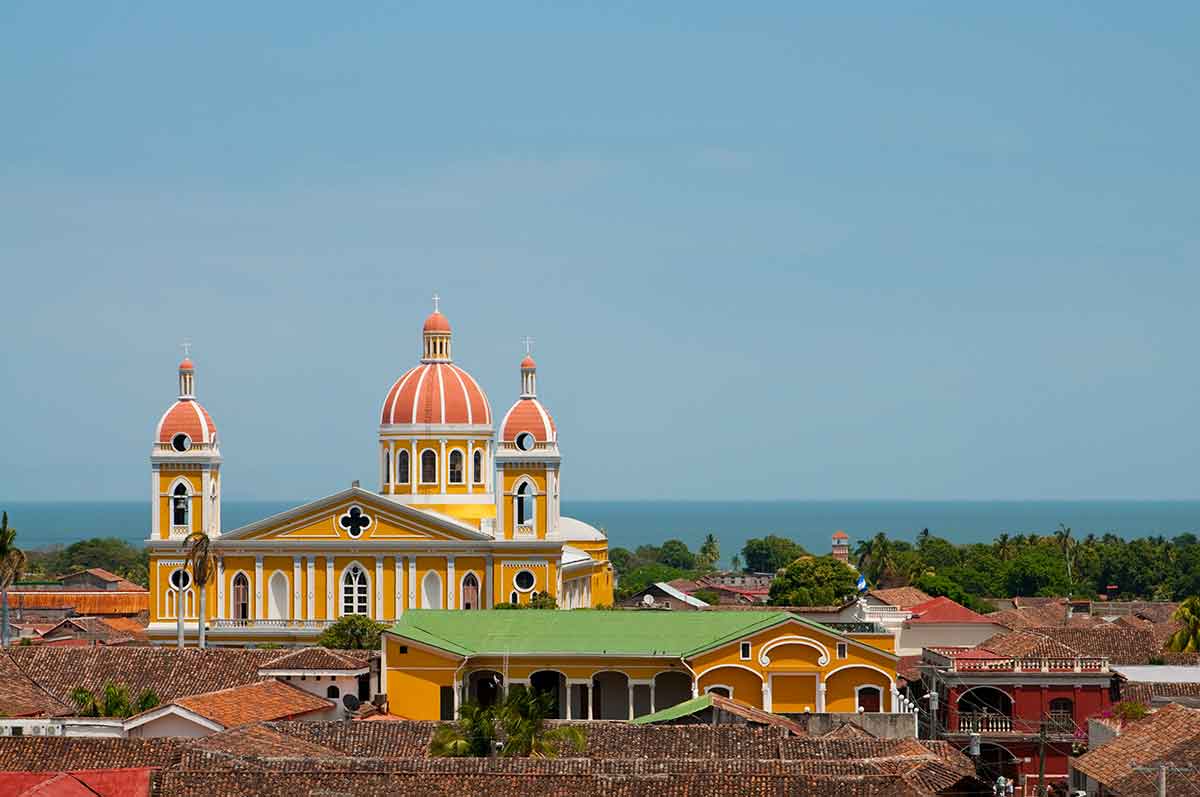
A destination that can be likened to an open-air museum, Granada is Nicaragua’s most historically significant city in Nicaragua.
The Spanish founded this colonial city in 1524 on the shore of Lake Nicaragua, a prime spot for a trading hub.
It has a long history of conquest, conflict and English pirates looking to loot.
Granada is famous for its neoclassical architecture, particularly its gorgeous, brightly coloured churches dating back to the Spanish Conquest.
Walking this city’s cobblestone streets is a feast for the eyes.
The Granada Cathedral is the city’s most prominent landmark, towering over the central plaza.
Its iconic red-tiled done, two bell towers and lemon-yellow façade can be seen from almost anywhere in the city.
The interior is just as stunning, featuring ornate statues and intricate stained glass windows.
This cathedral is a must-see while in Granada and with Granada’s position on Lake Nicaragua, you can easily take a boat tour of Las Isletas to explore the dozens of tiny islands that dot the coast.
They are teeming with birds, monkeys and even a fortress once used to protect the city from English pirates.
Mombacho Volcano is an ever-present feature, standing at 4409 feet (1344 m) high, just 6 miles (10 km) south of Granada.
If you’re a nature lover, a hike through the cloud forests of this dormant volcano is a must.
Granada Cathedral is at W2HW+WM Granada, Nicaragua.
The Central Plaza is at W2HW+XC Granada, Nicaragua.
Las Isletas are at 401 Calle El Arsenal, Granada, Nicaragua.
Book your transport around Granada here.
2- Managua
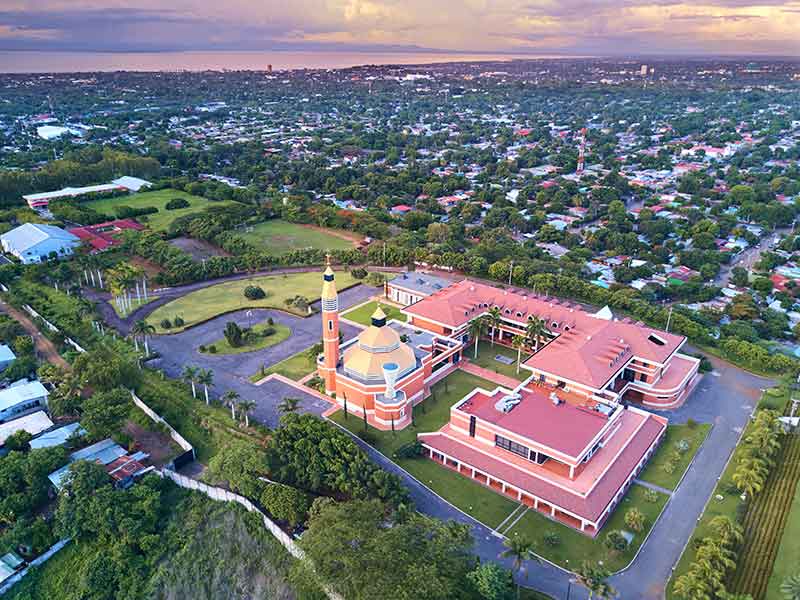
Managua is Nicaragua’s capital city and economic hub.
If you’re flying into the country, this is where you will land, as Managua is home to Nicaragua’s only international airport.
Travellers usually use this waterfront capital city as a starting point to bounce to other towns and cities in Nicaragua.
Managua’s convenient central location and major bus terminal make it easy to head north, south or to the coast.
Managua is sprawled along the southwestern shore of Lake Managua.
It has all the conveniences of a modern city, including shopping centres and a diverse international food scene.
Its bustling waterfront promenade is like an art installation, lined with brightly coloured metal trees that light up in the evenings.
Throughout Managua, you can still find remnants of its past.
The neo-Baroque Santiago of Managua Cathedral is one of the few buildings still standing after the city was levelled by an earthquake in 1972.
To go even farther back into Managua’s past, the Huellas de Acahualinca Archaeological Museum features a stretch of ancient footprints preserved in volcanic mud.
These footprints created by a small group of people and several animals are said to be around 6,000 years old.
- Managua International Airport is at 11 Carretera Norte, Managua 11072, Nicaragua.
- Managua Seawall and promenade is at 5P6G+8M Managua, Nicaragua.
- Santiago of Managua Cathedral is at 5P4H+G8P, 2a Avenida N.E, Managua 11001, Nicaragua.
- Huellas de Acahualinca Archaeological Museum is at Iglesia Santa Ana 4 calles al Oeste y 1 calle al Norte, Managua, Nicaragua.
3- Masaya
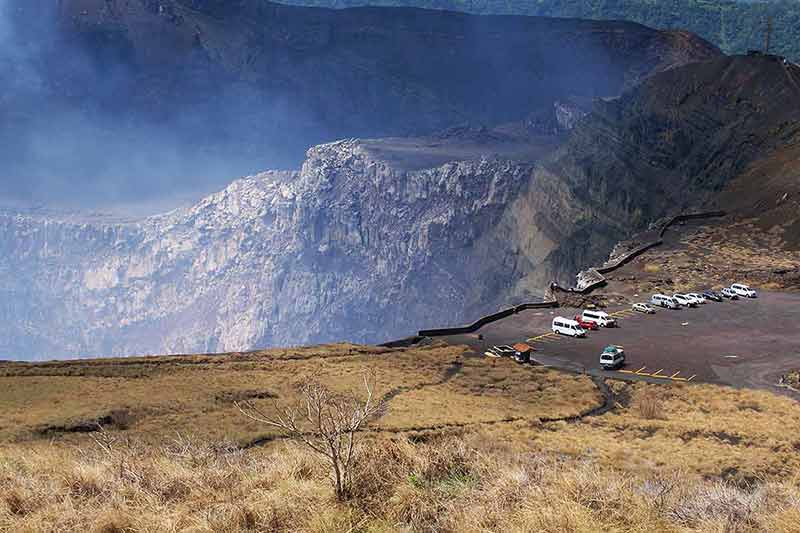
A city that’s called the Cradle of Folklore and City of Flowers, Masaya is the cultural hub of Nicaragua.
If that doesn’t sound like a city worth exploring, I don’t know what does!
Masaya sits between Managua and Granada, with its very active namesake, Masaya Volcano, less than 10 miles (15 km) to the west.
The volcano’s bubbling magma is a major attraction that draws people to this beautiful city.
It’s incredibly easy to take a chicken bus to the volcano and a quick hike up will lead you right to the crater.
I highly recommend going at sunset or for a night tour of the volcano. When the sun sets, the dancing, spitting lava is a sight you’ll never forget.
This folklore capital is renowned for shaping Nicaraguan culture through traditional music, dance and colourful street theatre.
Masaya’s handcrafted goods are particularly famous and can be bought in the city’s fantastic markets.
The Artisan Market is dedicated to selling just about every kind of Nicaraguan handcraft, from woven blankets, leather purses and sandals to handmade hammocks. It is organised and tourist-focused.
For a taste of the true chaos that comes with most Central American markets, head to the Municipal Market.
You can spend hours winding through its maze of lanes and stalls piled with fruit, vegetables, meats, clothes, handcrafts and so much more.
Masaya Volcano Entrance is at 2V32+99 Salgado, Nicaragua.
The Artisan Market is at XWF4+HH Masaya, Nicaragua.
The Municipal Market is at XWF7+88Q centro, Masaya, Nicaragua.
4- Nindirí
Nindirí city, also called the Volcano Village, sits at the base of Masaya Volcano, at the northern tip of Masaya Lagoon and is one of the oldest cities in Nicaragua.
Many pre-Columbian artefacts found in the area are housed in Museo De Nindirí.
Ancient pottery, tribal masks, idols and animal fossils showcase the indigenous history of Nindirí.
Nindirí has the most adorable parks in Nicaragua. Each one is themed and a joy to walk around.
Saurio Nindirí Park is a local favourite and has massive, brightly coloured dinosaur statues among the foliage.
Walk around the park, interact and snap photos with these ancient creatures.
Fruit Park has many charming fruit benches, each one in the shape of a different fruit complete with strawberry huts and watermelon-themed tables and stools.
This fruity park is a feast for the eyes, with its pops of colour along the green space.
As a fruit lover, I adore this park.
Central Park has large bird, frog and lizard statues throughout, with a vibrant gazebo-like centrepiece.
The Infantile Park has a whimsical castle entrance with a checkered floor and a fun play structure.
Saurio Nindirí Park is at 2V2M+6FQ, Nindirí, Nicaragua.
Fruit Park is at 2VWW+HQV, Los Altos de Masaya, Nicaragua.
Nindirí Central Park is at Av. Central Sur, Nindirí, Nicaragua.
Infantile Park is at 2V3M+4J8, Nindirí, Nicaragua.
5- San Juan Del Sur
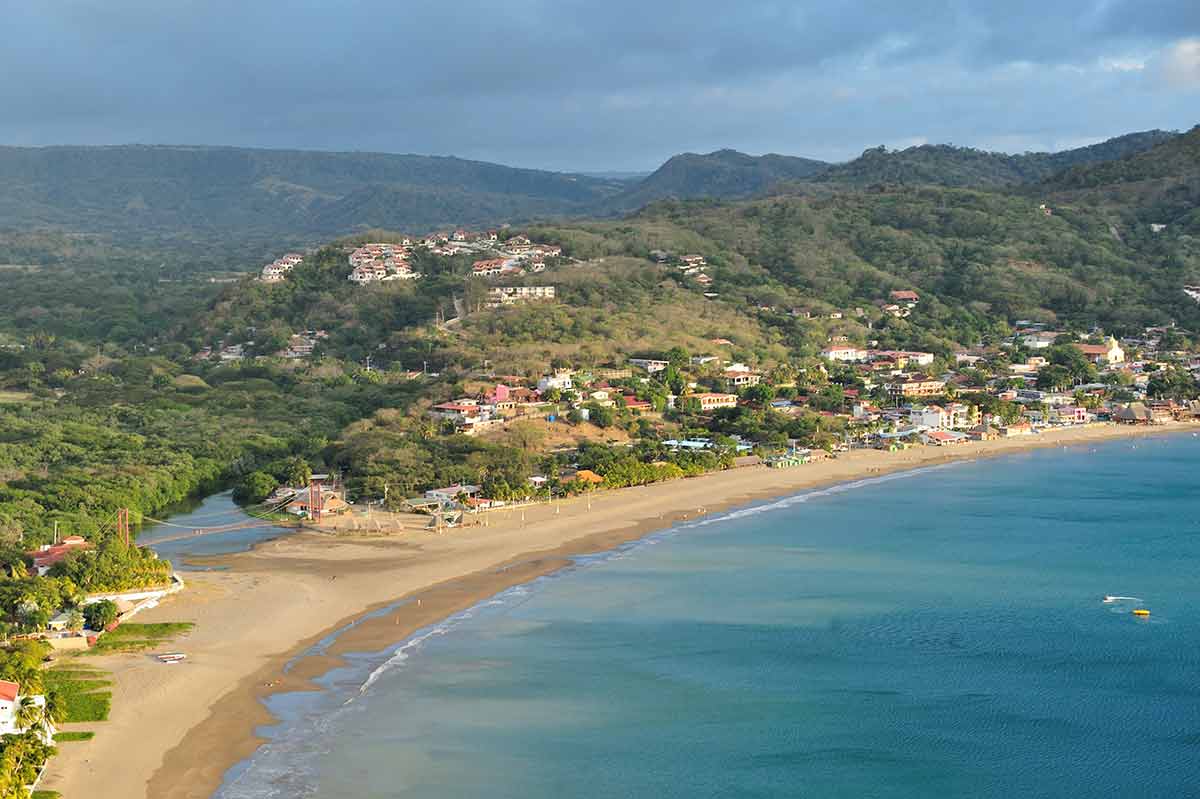
San Juan Del Sur is a cosy beach town on Nicaragua’s southwest coast that is popular with tourists for its laid-back atmosphere.
The town itself is inviting and colourful, with plenty of hotels and hostels around every corner and endless choices of restaurants to suit all tastes.
The town’s crescent-shaped beach is tucked in a bay dotted with boats, creating a postcard-perfect scene.
It has a long, soft stretch of sand and a gentle rolling swell, perfect for a leisurely swim.
Best of all, the sunsets at San Juan Del Sur beach are absolutely stunning.
People come from far and wide to surf San Juan Del Sur.
There are many places in town to rent a board or sign up for lessons and grab a shuttle to one of the best nearby surfing beaches.
I recommend booking lessons from Casa Oro as I had a great time learning to surf with them.
The gorgeous Maderas Beach, just north of San Juan Del Sur, is the best beach for all-level surfing.
You may also like to do an ATV adventure tour.
Casa Oro is at 742H+XG San Juan del Sur, Nicaragua.
Looking for more to do in Central America? Check out these:
6- Moyogalpa
Moyogalpa is the main town on Ometepe, the largest island in Lake Nicaragua.
Ometepe is comprised of two volcanoes: the tall, very much active, pyramid-shaped Concepción volcano (interested in climbing?) and the small, dormant Maderas volcano.
Taking a ferry from San Jorge will bring you to the port in Moyogalpa and a unique adventure ahead.
This town is the only spot on the island with a cluster of accommodations, shops, restaurants and most amenities you might need for a day of island explanation.
You can find these things throughout the island, but they are few and far between.
Rent a scooter in Moyogalpa and cruise around Ometepe at your own pace.
Many volcanic, black sand beaches, lagoons and jungle waterfalls are at your fingertips, with towering volcanoes as the centrepiece.
Catch an unforgettable sunset along Punta Jesús Maria, a mile-long (1.5 km) sand spit that extends into the lake on the island’s west side or go on a private kayaking trip.
San Jorge Ferry Terminal is at F665+2PX, C. del Lago, San Jorge, Nicaragua.
Punta Jesús Maria is at G76J+FGG, Lago Cocibolca, Esquipulas, Nicaragua.
7- Léon
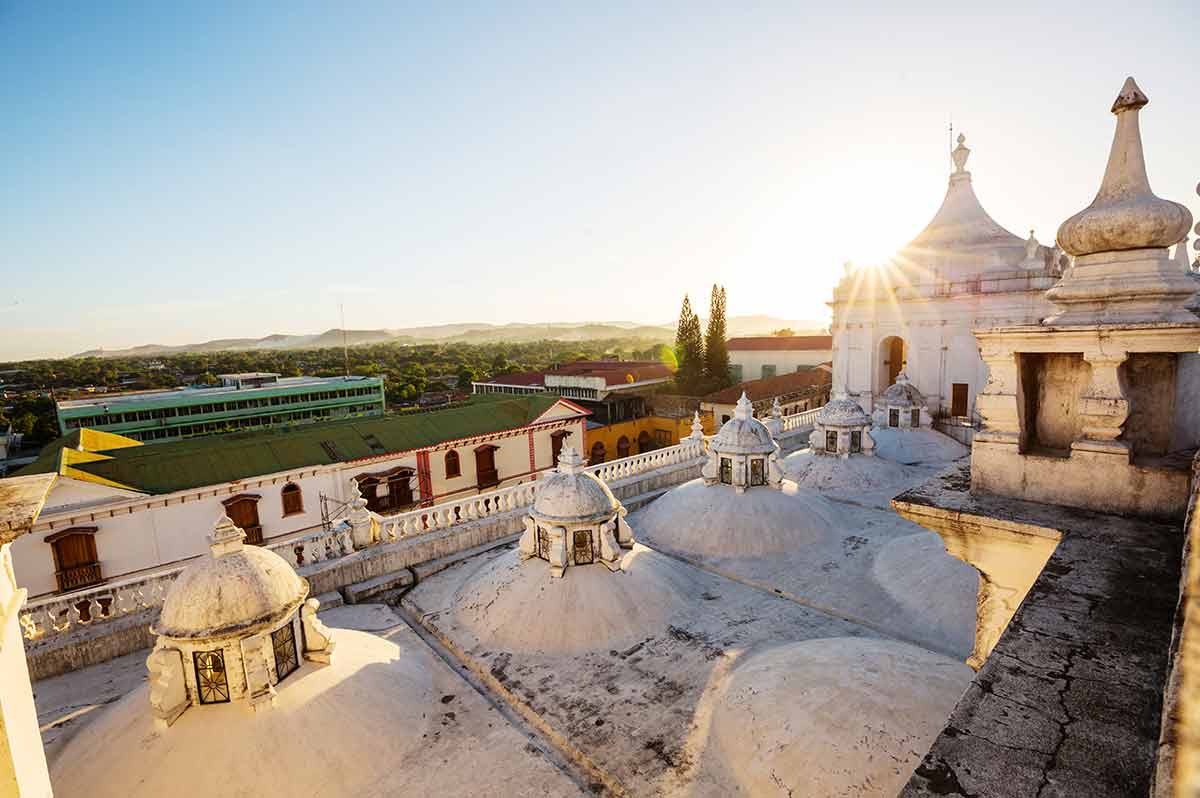
Founded in 1524, Léon is one of Nicaragua’s oldest cities and the centre of Nicaraguan revolutionary history.
The city’s original location was at the southern base of Momotombo Volcano.
After being decimated by an eruption, in 1610 it was moved to its present location.
Léon feels alive.
It’s a city with a lot of personality, heart and amazing food, much loved by students, artists, poets and intellects alike.
Beautiful murals are painted throughout the city, depicting its significant history.
Its colonial past is preserved in its architecture, with an impressive amount (over 15) of ornate churches from baroque to neoclassical styles.
The iconic and massive Cathedral of Léon is a jewel in the heart of the city and a UNESCO World Heritage Site that is the biggest cathedral in Central America.
No trip to Léon is complete without seeing its impressive interior with intricate statues and tombs.
Climb to the roof to walk between the domes and bells and admire the views of the city and the many volcanoes surrounding it.
Léon sits beside a stretch of six volcanoes along the Maribios chain.
Head to Cerro Negro 15.5 miles (25 km) east for an adventure sandboarding down the silky volcanic slopes.
The Cathedral of Léon is at Calle Rubén Darìo, Av. Central Nte., León, Nicaragua. Book a tour of Leon here.
8- Chinandega
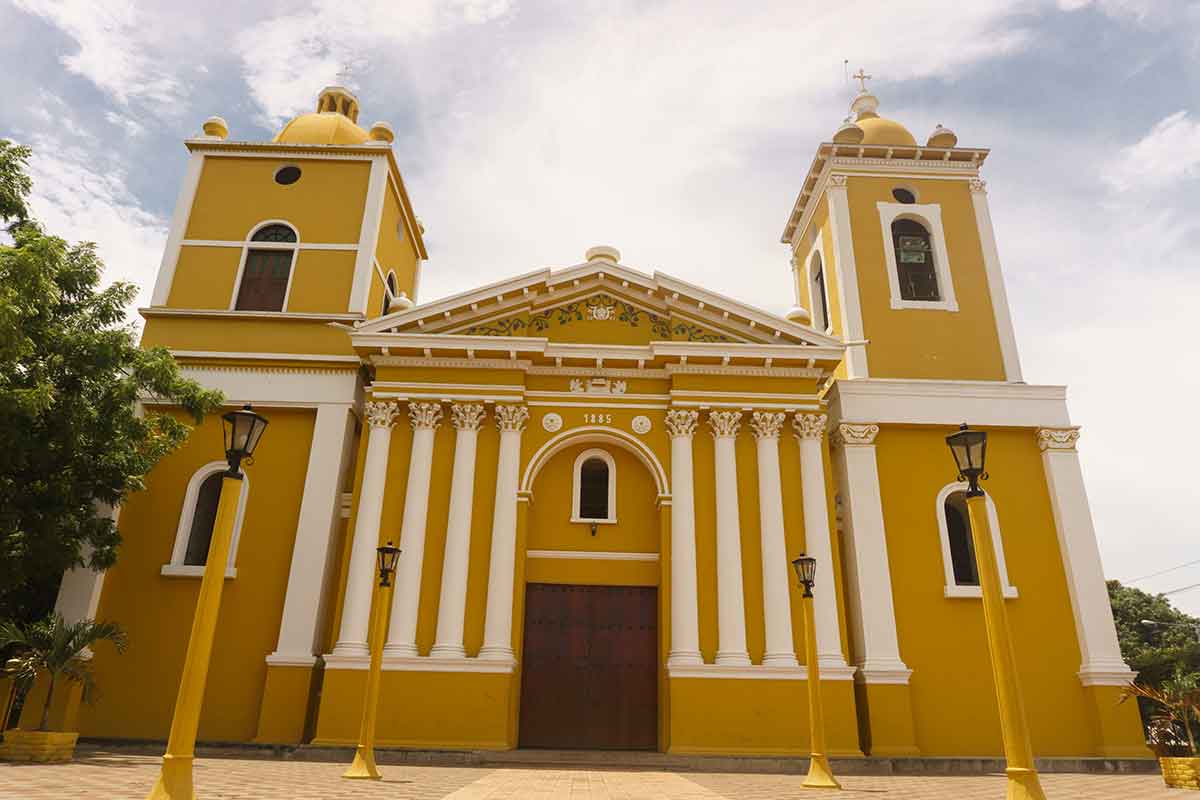
Chinandega sits in the northwestern region of Nicaragua, not far from the Honduras border. This city was inhabited by Amerindians long before the Spanish arrived.
The surrounding area maintains fertile, volcanic soil that produces healthy crops of sugarcane and peanuts.
These have been important crops for the city’s growth throughout the ages.
Chinandega is well-placed, with a plethora of volcanoes to the east, beautiful secluded beaches to the west and luscious greenery all around.
Its proximity to natural beauty makes it a desirable destination for travellers seeking outdoor adventure and Nicaraguan culture.
Chinandega is a resilient city, having been rebuilt after many significant events.
It was destroyed by an earthquake in 1885 and 1925, bombed and set ablaze during the Civil War in 1927 and decimated by a hurricane in 1998.
The city still displays a blend of colonial and indigenous influences.
The centre has the classic Latin American feature of a quaint plaza, accompanied by a gorgeous church.
Santa Ana Church is a bright yellow colonial church which houses its original, ornate altarpiece, said to be the most beautiful in the whole country.
Santa Ana Church is at JVJ8+Q4M, Costado Norte Parque Central, 1 Calle Nte., Chinandega, Nicaragua.
9- Esteli
Located in the country’s northern region, Esteli is Nicaragua’s agricultural capital and a centre of commerce for the surrounding farming communities. With those credentials, you better believe it has a spectacular market.
Mercado Alfredo Lazo market stalls sprawl onto the pavement, brimming with the freshest local fruit, vegetables, grains, meat and fish.
There are also many food vendors for delicious pupusas, enchiladas, gallo pinto and fresh juices to enjoy on the spot.
If you’re a cigar enthusiast, Esteli is your dream destination.
It’s world-renowned for manufacturing high-quality cigars, with many tobacco companies and crops in the area. Cuban cigar makers sought refuge here after the Cuban Revolution in 1959.
The city itself is laid-back and charming; colourful murals depicting important moments in Esteli’s history line the city walls.
There are also many Spanish Language schools throughout the city.
It’s a fantastic location to sink in and learn Spanish.
The Minaflor Nature Reserve is 18.5 miles (30 km) from Esteli.
This reserve is well-known for its biodiversity and is a haven for growing coffee.
Enjoy a day of orchid spotting throughout this luscious jungle, which is home to more than 200 species of orchids.
Mercado Alfredo Lazo is at 3JJV+78W, Carr. Panamericana, Estelí, Nicaragua.
10- Matagalpa
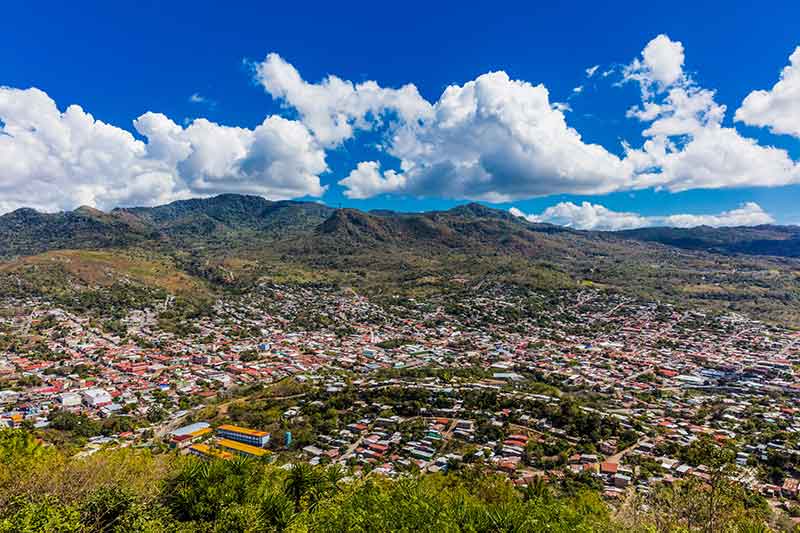
Matagalpa is called the Pearl of the North and was originally an indigenous village inhabited by the resilient Cacaopera people, who had their own unique language.
The language officially went extinct in the late 19th century.
It took the Spanish 300 years to conquer the Cacaopera people and even still, they remained in the area.
Matagalpa is tucked in a green valley between mountainous peaks; the land is famous for its coffee plantations.
The region’s coffee is known for its unique, deep chocolate flavour.
Enjoy a coffee tour in the Cerro Arenal Nature Reserve just south of the city.
Visit the Coffee Museum in the city centre to learn more about coffee customs, history and its importance to the indigenous people.
The museum is complete with archaeological displays, documents, photographs and reconstructions.
The city moves at a different pace than most Nicaraguan cities.
It’s relaxed and feels like old times, complete with ox carts and mules throughout the streets.
Cerro Arenal Nature Reserve is at W38M+CFP, Matagalpa, Nicaragua.
The Coffee Museum is at W3GJ+JF5, Matagalpa, Nicaragua.
11- Las Peñitas
Las Peñitas is a quaint little fishing town on Nicaragua’s northwest coast.
This town offers a more relaxed atmosphere than the country’s southern beach towns, which are popular with travellers because of their proximity to the Costa Rican border.
A 2.4 mile (3.9 km) stretch of beach is divided into two, Playa Peñitas and Playa Poneloya. Nicaragua’s wild Pacific coast is a surfer’s paradise, with Playa Peñitas being a local favourite.
There are surf schools and board rental shops in town if you wish to give it a go, or you can sit back and watch the talented locals shred the waves.
Playa Poneloya is a popular weekend destination for Nicaraguan families.
Horses are available for hire, and along with a guide, riders can leisurely trot along the vast sandy shores.
Like many other Nicaraguan beaches along the Pacific coast, the sunsets are incredible. Walk around the harbour at dusk and watch the busy fishermen bustle about as the sun goes down.
Juan Venado Island is made up of mangrove that runs parallel to the coast.
It’s separated from the mainland by a narrow estuary. It’s part of the Juan Venado Nature Reserve just south of Las Peñitas.
Take a boat tour or hire a kayak to cruise around the mangroves to explore an area teeming with birds, snakes, crabs and crocodiles.
12- El Castillo
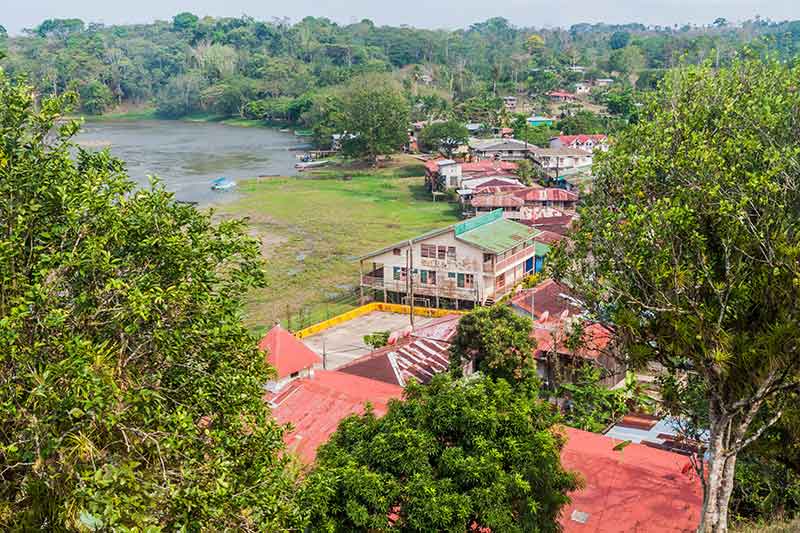
Step into rural Nicaraguan life in El Castillo, a tiny picturesque town in the southern region on the San Juan River.
The town is truly off the beaten path; even getting there can be an exciting adventure.
Hop on a boat in San Carlos on the southeast coast of Lake Nicaragua, and cruise along the San Juan River until you reach El Castillo.
The town has no cars; it can easily be explored on foot.
As its name suggests, the main feature of El Castillo is the fortress strategically positioned in front of the river rapids.
It was built in 1672 to protect larger cities farther north from frequent pirate attacks.
The fortress includes a small museum showcasing its history with artefacts like arms, cannon balls and old rum bottles on display.
Indio Maís Biological Reserve is one of Nicaragua’s largest and most breathtaking nature reserves.
It’s just a stone’s throw away from El Castillo.
Book a tour from the Tourist Information Centre at the main dock in town and bask in a world of parrots, monkeys, caiman, ocelots and poison dart frogs.
El Castillo Fortress is at 2J93+G6W, El Castillo, Nicaragua.
13- Juigalpa
Juigalpa’s claim to fame comes from its renowned Patron Saint Festival every August, the best in Central America.
The week-long festivities have the city buzzing with fairs, street vendors, performances, entertainment and more. People flock from all over Central America to join in.
It’s particularly popular with cowboys; bull riding is a festival highlight.
Much of the action takes place at one of the city’s bullrings.
Gregorio Aguilar Barea Museum is another of Juigalpa’s treasured attractions.
This archaeological museum started when students began searching for relics of the past.
As it turned out, the countryside was ripe with treasure.
Locals came forward, donating artefacts they had found and used to decorate their homes.
This collection of pre-Columbian pieces includes gold, amulets, pottery, funeral jars and a breathtaking range of intricate statues dating back 1000 years.
A large cemetery sits in Juigalpa’s centre. Go for a leisurely stroll paying respects to ancestors and admire the maze of colourful tombs.
Gregorio Aguilar Barea Museum is at 4J5P+3MX, C. a Palo Solo, Juigalpa, Nicaragua.
Juigalpa Municipal Cemetery is at 4J3M+636, Juigalpa, Nicaragua.
14- Jinotega
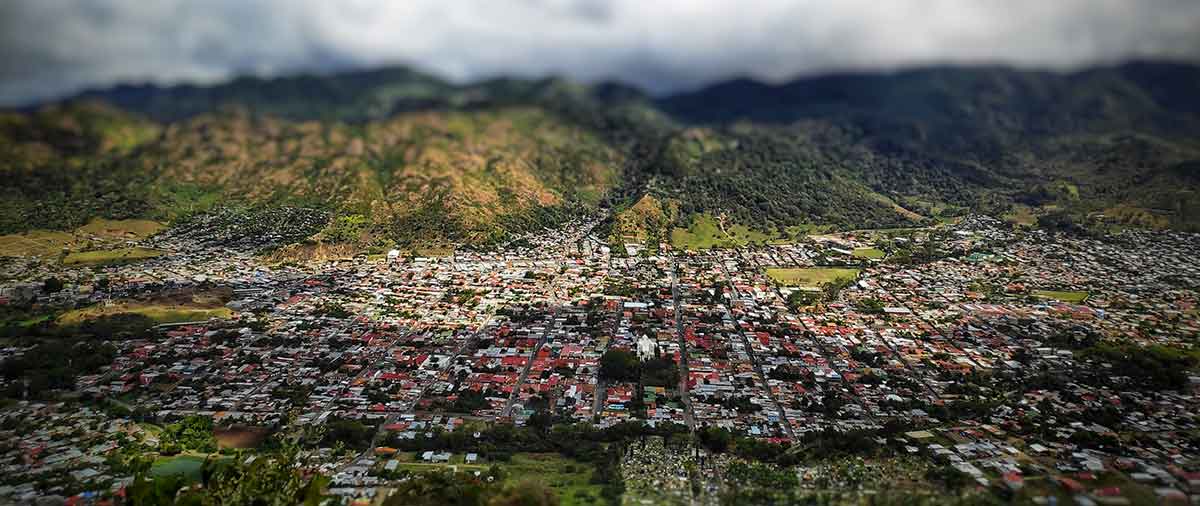
The city of Jinotega sits within a valley encircled by towering mountain peaks and called the City of Mists for the continuous clouds that wisp through the valley top.
Nicaragua’s mountains are renowned for coffee growth, and Jinotega’s surroundings are no exception.
It’s considered the coffee capital of Nicaragua; the region produces 65% of the country’s coffee.
A perimeter of peaks around the city creates fantastic opportunities for hikes with the end result being a stunning lookout.
Peña de La Cruz on Jinotega’s west side will have hikers climb 900 steps to reach the top.
A towering cross is perched on a rock at the summit with sweeping views of the city, Lake Apanás and beyond.
Jinotega’s central park is a bustling hub where locals gather.
The park’s lush greenery is laced with vibrantly coloured benches, fences and murals, complete with a skate park, play area and a library.
You might even spot a sloth or two as you stroll through.
The city is a perfect launchpad for some serious outdoor adventures. Lake Apanás and Cerro Dantali El Diablo Natural Reserve are just a few miles away from Jinotega, waiting to be explored.
Peña de La Cruz is at 3XRP+WM6, Jinotega, Nicaragua.
Jinotega’s Central Park is at 3XRW+QP Jinotega, Nicaragua.
15- Somoto
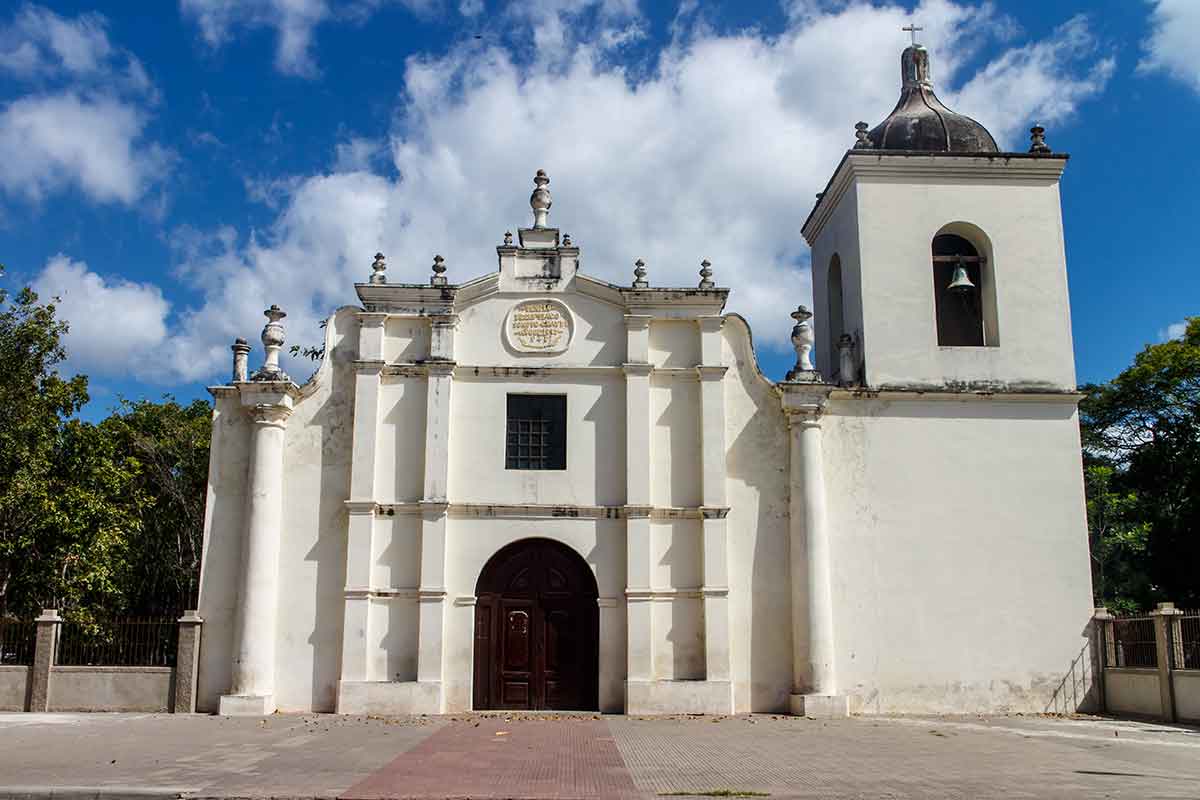
Experience the relaxed pace of local Nicaraguan life in Somoto, a northern city close to the Honduras border.
Somoto has all the hallmarks of a classic Nicaraguan city.
Adobe buildings with pops of bright colours line cobblestone streets and a tranquil central plaza accompanied by a gorgeous church.
This one comes with a clock tower!
The thing to do in Somoto is have coffee and nibble on rosquillas. Rosquillas are crunchy doughnuts made from cornmeal, cheese and sugar.
This sweet and savoury snack is a Somoto staple, sold all over the city.
Somoto is considered the birthplace of rosquillas.
You can even take a rosquilla workshop to learn how to make these traditional treats.
What attracts most people to Somoto is its spectacular canyon only 9 miles (14.5 km) from the city. Coco River carved its way through the rock millions of years ago, forming this stunning canyon.
It was declared a National Monument in 2006.
Sheer rock walls vertically rise more than 330 feet (100 m) from the winding river.
Visitors can hike through the canyon, discover caves, jump off boulders into natural pools and enjoy the remote solitude between the majestic canyon walls. Find out more about the canyon here.
Somoto Canyon is at F877+8M9, Valle El Guayabo, Nicaragua.
16- Jiquilillo
Gently swaying in a hammock surrounded by palm trees and the sound of waves lapping onto the shore, that is life in Jiquilillo, a salty sea paradise.
Jiquilillo is first and foremost a fishing village. Every morning, the beach becomes a fish market where families and shopkeepers come to buy the catch of the day.
Afternoons are spent strolling along the long stretch of uninterrupted beach, nibbling on the town’s famous coconut bread.
In the misty distance is a glimpse of Cosigüina Volcano. Cosigüina Volcano Natural Reserve is 27.5 miles (44.5 km) north of Jiquilillo.
Inject a bit of daring adventure between days of twiddling toes in the sand and trek to this nature reserve.
Hiking up Cosigüina Volcano is not challenging, and I couldn’t recommend it enough.
Views of the massive crater and its sunken turquoise lake are unforgettable.
You can also see the mountains of El Salvador and Honduras beyond the Gulf of Fonseca.
17- Mancarrón
Sometimes, we all need a proper escape from cities, chicken buses, markets and the sounds that come with it.
In Mancarrón, that life comes to a grinding halt.
This town is part of the Archipelago of Solentiname in the southernmost corner of Lake Nicaragua.
The real adventure is getting there.
Boats frequently come and go from San Carlos, the closest city where islanders stock up on provisions.
Grab some delicious baked goods in town (its baguettes and doughnuts are spectacular) and hop on the wooden boat alongside locals laden with supplies.
The slow chugging journey on the water matches the pace of life in Manacarrón, and all city sounds fade away.
The definition of ‘unplugged’ comes to life in Mancarrón; this is a place to just be.
A small cluster of buildings near the port consists of two shops, a library, a smattering of houses and the quirky, colourful Iglesia Solentiname.
Wander the dusty paths and admire artists immersed in painting; this island is an artist’s haven.
Hire a kayak and paddle between nearby islets, basking in the sound of gentle waves, chattering parrots, grunting howler monkeys and spotting turtles along the way.
Swing in a hammock, sipping the local palm wine.
Iglesia Solentiname is at 5XFX+RGJ, Mancarrón, Nicaragua.
18- Bluefields
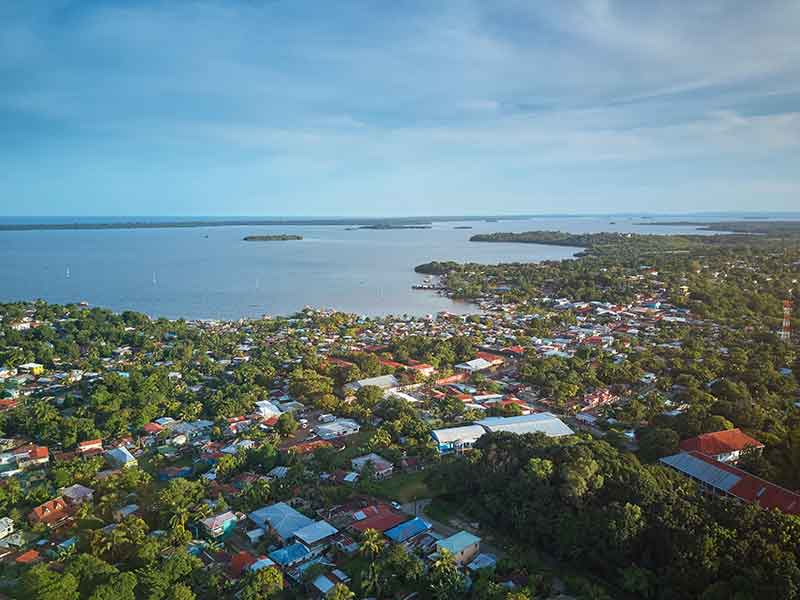
Bluefields, a city founded by a pirate, is the main city on Nicaragua’s Caribbean coast, also called the Miskito Coast.
Bluefields was conquered by the English, used as a meeting point for English and Dutch pirates and inhabited by stranded slaves.
The city may be rough around the edges but has droves of colourful Caribbean charm nonetheless.
People come to experience the culture, a mix of indigenous, African and English, where Creole is widely spoken.
Bluefields has a vibrant nightlife. Many clubs fill the air with music and dancing, as you would expect from any strong Caribbean culture.
Music and dance is deep within its roots.
Don’t pass up the chance to taste the delectable rondon, a Caribbean staple.
This thick stew consists of coconut milk, yuca, taro, plantain and a mix of whatever seafood is on hand, like conch, crab, lobster and fish, usually complete with dumplings.
Trust me, it’s delicious!
19- Pearl Lagoon
Pearl Lagoon is a town on the edge of a lagoon of the same name.
The town itself may not be the most exciting but is the gateway to tropical, desert island bliss.
Pack a picnic and hop on a boat for a day trip to the Pearl Cays, a set of 18 uninhabited cays off Nicaragua’s Caribbean coast.
Each cay is palm-fringed and surrounded by soft sand and crystal-clear water.
Bask in the tropical sun, splash about in the warm waters or lay lazily on the beach.
The Pearl Cays aren’t yet on the busy tourist path, so you will likely have an island to yourself for the day, giving you a proper deserted island experience.
The cays are teeming with sea life, so bring along snorkel gear and watch the creatures happily float by.
Dolphins call the area home, so you may even spot them on the boat ride back to Pearl Lagoon.
20- Big Corn
Big Corn is an Island 50 miles (70 km) off Nicaragua’s Caribbean coast.
Despite its name, it’s a rather small island at 3.9 square miles (10 sq km) with a smattering of development all along its perimeter.
Big Corn is your ticket to an island experience like no other.
It’s not fancy and doesn’t have a big tourist infrastructure like much of the Caribbean. But you will happily find everything you need: simple, fresh food, a place to snooze and postcard-perfect surroundings.
This is local island life that dances to the beat of its own drum.
Get ready to live by island time; everything slows down and happens when it happens.
The interior is verdant and hilly; the coast is sparkling aquamarine.
The thing to do is beach hop. A multitude of beaches, both large and small and secluded, line the island.
All of them are gorgeous and ideal for hours of lounging, snorkelling and scuba diving.
For an even more rural but tropical experience, head to Little Corn Island 8 miles (12.8 km) away.
Little Corn lives up to its name at a mere 1.1 sq miles (2.9 sq km) in size.
There are no cars on the island and wheelbarrows are a hot commodity to cart loads to and fro. What you will find are relaxed, smiling locals and even more tropical bliss.
Plan Your Trip

Rent A Car – Find the best car rental rates at Discover Cars. They compare car hire companies to provide you with the best deal right now.

Find A Hotel – If you’re curious about this article and are looking for somewhere to stay, take a look at these amazing hotels.

